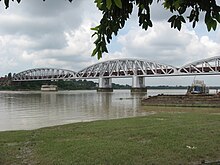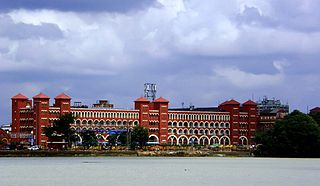
Howrah is a city in the Indian state of West Bengal. Howrah is located on the western bank of the Hooghly River, opposite its twin city of Kolkata. Administratively Howrah lies within Howrah district and is the headquarters of the Howrah Sadar subdivision; it is also part of the area covered by Kolkata Metropolitan Development Authority (KMDA). Howrah is an important industrial and transportation hub, and is also a gateway to Kolkata via Howrah railway station and Howrah Bridge.

Nadia is a district in the state of West Bengal, India. It borders Bangladesh to the east, North 24 Parganas and Hooghly districts to the south, Purba Bardhaman to the west, and Murshidabad to the north.

Vivekananda Setu is a bridge over the Hooghly River in West Bengal, India. It links the city of Howrah, at Bally, to Kolkata, at Dakshineswar. Completed in 1931, it is a multispan truss bridge that was built to primarily to provide direct road and rail connectivity between the Calcutta Port and the major railhead at Howrah railway station on the West bank of the Hooghly River. It is 880 metres (2,887 ft) long having 9 spans in total. The famous Dakshineswar Kali Temple is situated on the banks of the Hooghly River near the bridge. The bridge is one of the four bridges linking Howrah and Kolkata. A new road bridge, the Nivedita Setu, was constructed 50 m (160 ft) downstream in 2007 due to weakening of the Vivekanada Setu caused by its ageing.

Hugli-Chuchura, also known by its former names Chinsurah or Hooghly-Chinsurah, is a city of Hooghly district and the district headquarters of Hooghly division in the Indian state of West Bengal. It is one of the densely populated cities of West Bengal. It lies on the bank of Hooghly River, 35 km north of Kolkata, the state capital. It is located in the district of Hooghly and is home to the district headquarters. Chuchura houses the Commissioner of the Burdwan Range. The District Court building of Chinsurah is the longest building in West Bengal. It is a part of the area covered by Kolkata Metropolitan Development Authority (KMDA).

Jangipur is a city and a municipality in Murshidabad district in the state of West Bengal, India. It is the headquarters of the Jangipur subdivision. It is situated on the banks of the Bhagirathi. Jangipur is an old town having reference from the historical period of Moghul emperor Jahangir when an army camp was established here.

The Geography of West Bengal, a state in eastern India, is primarily defined by plains and plateaus, with the high peaks of the Himalayas in the north and the Bay of Bengal to the south.
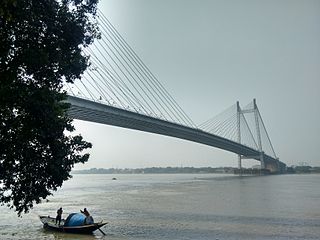
Kolkata the Capital of the Indian state of West Bengal has a good transportation system. Kolkata's transport system is diverse, with a mix of modern and traditional modes of transport catering to the city's large population.

Bansberia is a city and a municipality of Hooghly district in the Indian state of West Bengal. It is about 45 km (28 mi) away from Kolkata, at the western end of the Iswar Gupta Setu (Kalyani-Bansberia) Bridge. It is a part of the area covered by Kolkata Metropolitan Development Authority (KMDA). Bans Beria railway station is 4 km from Bandel Junction on the Bandel-Katwa Line.The area covered by two police stations - Chinsurah (W.no.1-4) and Mogra (W.no.5-22). The part of both Police Stations governed by Chandannagar Police Commissionerate. Kartik Puja is the famous festival of Bansberia. Bansberia also famous for it's Kumbh Mela.

Dhuliyan is a municipality town in the Samserganj block of Jangipur subdivision of Murshidabad district in the state of West Bengal, India. This municipality was established in the year 1909 and comprises 21 wards. It is located between the Ganges and the Feeder canal.
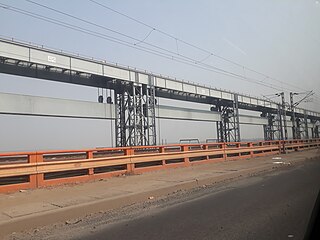
Farakka Barrage is a barrage across the Ganga river located in Murshidabad district in the Indian state of West Bengal, roughly 18 kilometres (11 mi) from the border with Bangladesh near sahibganj. Farakka Barrage Township is located in Farakka in Murshidabad district. Construction of the barrage started in 1962, and was completed in 1970 at a cost of 1 billion dollars. It became operational on 21 April 1975. The barrage is about 2,304 metres (7,559 ft) long. The Feeder Canal (Farakka) from the barrage to the Bhagirathi-Hooghly River is about 42 km (26 mi) long.

Murshidabad district is a district in the Indian state of West Bengal. Situated on the left bank of the river Ganges, the district is very fertile. Covering an area of 5,341 km2 (2,062 sq mi) and having a population 7.103 million, it is a densely populated district and the ninth most populous in India. Berhampore city is the headquarters of the district.

Guptipara is a village in Balagarh, a community development block that forms an administrative division in the Sadar subdivision of the Hooghly district in the Indian state of West Bengal.

Tribeni is a neighbourhood in Bansberia of Hooghly district in the Indian state of West Bengal. It is a part of the area covered by Kolkata Metropolitan Development Authority (KMDA).
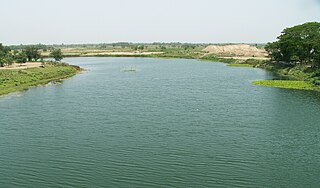
Jalangi River, is a branch of the Ganges river in Murshidabad and Nadia districts in the Indian state of West Bengal. It flows into the Bhagirathi river and strengthens its lower channel, the Hooghly.
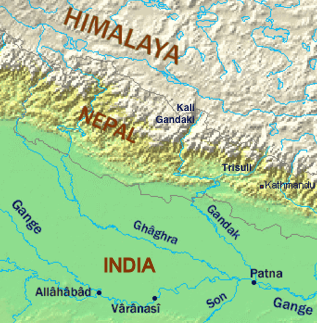
A long-standing dispute exists between India and Bangladesh over the appropriate allocation, and development, of the water resources of the Ganges River, which flows from northern India into Bangladesh. The issue had remained a subject of conflict for almost 35 years, with several bilateral agreements and rounds of talks failing to produce results.

Farakka is a community development block that forms an administrative division in the Jangipur subdivision of Murshidabad district in the Indian state of West Bengal.
Azimganj Junctionrailway station is a railway station on the Barharwa–Azimganj–Katwa loop and is located in Azimganj City of Murshidabad district lying west of Bhagirathi, a part of the Hooghly river in the Indian state of West Bengal. It serves Jiaganj Azimganj municipality.

The Barharwa–Azimganj–Katwa loop is a railway line connecting Barharwa on the Sahibganj loop and Katwa. Together with the Bandel–Katwa line, which connects this line to Bandel Junction on the Howrah–Bardhaman main line, it is also known as the B.B Loop Line. This 170 kilometres (110 mi) line is under the jurisdiction of Eastern Railway. The majority of this line passes through the Purba Bardhaman and Murshidabad districts, in the Indian state of West Bengal, and lies on the west bank of the Bhagirathi river.

Feeder Canal is a canal associated with Farakka Barrage. It is located in Murshidabad district, West Bengal. The canal is 38.3 km long. The Ganges water from the Farakka Dam is being conveyed to Bhagirathi by way of this canal. Due to the flow of river Hooghly through the Farakka dam project, around 40,000 ft3/s of water is available daily in the Feeder connection. The Feeder canal has been designed keeping in mind the ability to carry this amount of water. However, during the dry season, less water is released. The dry season is from January to May. During the period the flow of water in the feeder canal is reduced from ca. 40,000 ft3/s to 30,000-28,000 ft3/s. If the severe drought brings down the Ganges water from its upper reaches, then less water is available in feeder canal.
River bank erosion along the Ganges in Malda and Murshidabad districts focusses on river bank erosion along the main channel of the Ganges in Malda and Mushidabad districts of West Bengal, India.






